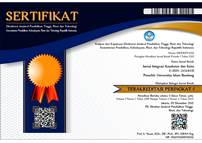Hubungan Letak Lesi Strok Iskemik dengan Kualitas Tidur di RSAU dr. M. Salamun Bandung
Abstract
Prevalensi strok di Indonesia terus meningkat seiring dengan usia harapan hidup yang semakin meningkat dan menyebabkan banyak kematian. Pasien strok terutama strok iskemik dapat mengalami berbagai macam gangguan tidur. Macam gangguan tidur pada penderita strok bergantung pada defisit neurologis yang dialaminya. Tujuan penelitian ini mengetahui hubungan lokasi lesi strok iskemik daerah kortikal dan subkortikal dengan kualitas tidur menggunakan pemeriksaan Pittsburgh Sleep Quality Index (PSQI) di RSAU dr. M. Salamun Bandung. Penelitian ini merupakan penelitian observasional dengan rancangan penelitian potong lintang. Penelitian dilakukan terhadap 38 penderita yang pertama kali didiagnosis strok iskemik yang dirawat inap di Bagian Neurologi RSAU dr. M. Salamun Bandung pada bulan Juni sampai Oktober 2016. Instrumen penelitian berupa kuesioner PSQI yang dilakukan pada hari ke-7 pasien dirawat inap. Statistical for social science (SPSS) versi 17 digunakan untuk mengolah data. Hasil penelitian menunjukkan terdapat hubungan bermakna lokasi lesi strok iskemik daerah kortikal dan subkortikal dengan kualitas tidur (p=0,215). Penderita strok iskemik dengan lokasi lesi hipodens subkortikal yang mengalami gangguan kualitas tidur sebesar 23 dari 28 subjek dan lokasi lesi hipodens kortikal sebesar 3 dari 9 subjek.
RELATIONSHIP BETWEEN ISCHEMIC STROKE LESIONS AND SLEEP QUALITY AT RSAU DR. M. SALAMUN BANDUNG
The prevalence of stroke in Indonesia continues to increase with increasing life expectancy and it causes many deaths. Stroke patients, especially ischemic stroke can experience a variety of sleep disorders. The types of sleep disorders in stroke patients depend on the neurological deficits they experience. The purpose of this study was to study the relationship between the location of cortical and subcortical ischemic stroke lesions with the quality of sleep using Pittsburgh Sleep Quality Index (PSQI) examination in RSAU dr. M. Salamun Bandung. This study was an observational study with a cross sectional study design. The study was conducted on 38 patients who were first diagnosed with a stroke in the Neurology Department of RSAU Dr. M. Salamun Bandung in June to October 2016. The research instrument consisted of the PSQI questionnaire conducted on the 7th day of hospitalized patients. Version 17 of the social sciences statistics (SPSS) was used to process data. The results showed that there was a correlation between the location of cortical and subcortical ischemic stroke lesions with the quality of sleep (p=0.215). Ischemic stroke patients with subcortical hypodense lesions who experienced sleep quality disorders were 23 of 28 and patients with cortical hypodens lesions were 3 of 9 patients.
Keywords
Full Text:
PDFReferences
Sacco RL, Kasner SE, Broderick JP, Caplan LR, Connors JJ, Culebras A, dkk. An updated definition of strok for healthcare professionals from the American Heart Association/American Strok Association. J AHA. 2013;44(7):2064–89.
Jones DL, Adams RJ, Brown TM, Carnethon M, Dai S, Simone GD, dkk. Heart disease and strok statistics 2010 update: a report from the American Heart Association. J AHA. 2010;121(7):e46–e215.
Badan Penelitian dan Pengembangan Kesehatan. Proporsi penyebab kematian pada kelompok umur 55-64 tahun menurut tipe daerah. Laporan Hasil Riset Kesehatan Dasar (Riskesdas) Nasional 2007. Jakarta: Departemen Kesehatan Indonesia; 2018.
Kusuma Y, Venketasubramanian N, Kiemas L, Misbach J. Burden of stroke in Indonesia. Int J Stroke. 2009 Oct;4(5):379–80.
Misbach J, Ali W. Stroke in Indonesia: a first large prospective hospital based study of acute strok in 28 hospitals in Indonesia. J Clin Neurol. 2000;8(3):245–9.
Klaus KA, Tom SO, Christian D, Lars PK. Hemorrhagic and ischemic strok compared, strok severity, mortality and risk factor. J AHA. 2009;40:2068–72.
Kim J, Kim Y, Yang KI, Kim D, Kim A. The relationship between sleep disturbance and functional status in mild strok patients. Ann Rehabil Med. 2015;39(4):545–52.
Jennum P, Cano JS, Bassetti C, Clarenbach P, Holg B, Mathis J, dkk. Sleep disorders in neurodegenerative disorder and stroke. Dalam; European handbook of neurological management. Volume 1. Edisi ke-2. Hoboken, New Jersey: Blackwell Publishing Ltd; 2011. hlm. 529–38.
National Stroke Association. Recovery after stroke: sleep disorders. 2006.
Derfiani PH. Correlation between sleep quality and cerebral infarction location. Kumpulan naskah ilmiah dan abstrak, INASleep, Perdossi Cabang Bandung, FKUP-RSHS. September 2016.
Dwipa L. Proses menua, ritme sirkadian dan tidur. dalam Kumpulan Naskah Ilmiah dan Abstrak, INASleep, Perdossi Cabang Bandung, FKUP-RSHS. September 2016.
DOI: https://doi.org/10.29313/jiks.v1i2.4637
Refbacks
- There are currently no refbacks.
Jurnal Integrasi Kesehatan dan Sains is licensed under a Creative Commons Attribution-NonCommercial-ShareAlike 4.0 International License.







.png)
_(1).png)




















